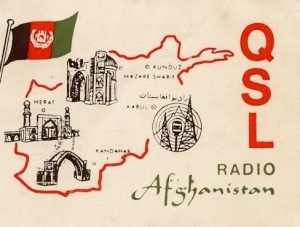
The only radio spectrum that has met it’s demise faster than AM is the spectrum known as short-wave radio. Although not entirely dead, and showing signs of resurrection, the portion of radio spectrum found above the AM band has become a shadow of what it once was. However, radio observers & industry writers are just beginning to take a second look at this over-looked means of communication as a functional tool for today & the future. Although never truly popular in the US & Canada as a popular source of information & entertainment, the short-wave broadcast bands in Europe, although not what they once were in popularity, continue to attract & retain listeners in this millennium. Short-wave broadcasting in much of the Third World continues to dominate as a means of providing radio services to sparse, rural & isolated populations.

Short-wave broadcast antenna array
There are three main reasons short-wave radio has been sent into near oblivion & this occurred in the 1990’s after a period of long & steady growth since radio broadcasting came in usage in the 1920’s. The first was a change in the world’s political climate during a period of relative stability & peace on our planet. It was the closest we’ve come to ending the “Cold War”. The Berlin Wall had come down, the dissolution of the communist dominated USSR into a more friendly & co-operative regime occurred, China’s hardcore political stance was making overtures to co-operation, participation & trade with other nations notably in ‘the west’, & Middle East turmoil was at a minimum. The need for voices of propaganda & accusatory doom & gloom via short-wave radio seemed to diminish in intensity & mandate. The second significant factor that has nearly killed off short-wave is the advent of the Internet. The fast growth of of the ‘Net has become the dominant means by which most consumers acquire news & entertainment in affluent nations. Today, we rely on Facebook & Twitter news feeds, a myriad of online news sources & podcasts & derive much of our entertainment & music acquisition & consumption via the ‘Net. This contributed to a redundancy & lessening of the importance of nations worldwide operating short-wave broadcasting facilities to spread news. However, while we take for granted connectivity & wireless access points in civilized, western nations, there are still many countries & parts of our planet without Internet service or even the means for accessing the Internet via computers & hand-held devices. The citizens of our planet’s poorer nations have neither the means nor the access to computers & Internet services & still rely on radio as their main source of communications. Nations throughout Africa & the Indian & south-east Asian sub-continents continue to operate short-wave transmitters to reach their citizens in conjunction with AM & FM. In Europe, where short-wave broadcasting was once as popular & dominant as AM or FM, some short-wave broadcasting does remain, but countries operating short-wave facilities continues to decrease. At one time, it was common to find the 2 most popular short-wave bands included on car radios – one band of frequencies the primary means of long-distance day signal propagation, the other for hours of darkness throughout Europe. Romania is the latest EU country to announce discontinuation of it’s short-wave radio services. The third significant factor in the demise of short-wave can be illustrated by number of EU countries have already shut down services citing land usage costs & high electrical power requirements to operate facilities. Short-wave stations require even larger plots of land to erect multi-tower arrays than do AM broadcasters. The electrical costs involved in operating 100- 600 kW short-wave transmitters have also become a favorite target for governments looking to trim operating budgets. The elimination of short-wave broadcasting is an easy decision that isn’t likely to irritate or annoy taxpayers & many governments have opted to do so.




What is to be heard on today’s short-wave dial? Many countries still maintain international broadcasts to inform the world of their news & perspective on world affairs, in addition to local music & culture. Most Third World countries operate short-wave “domestic” stations geared to providing their own citizens with government radio service & also license short-wave supplements to AM & FM commercial stations. In Europe, many once popular international stations such as the UK’s BBC World Service, Radio Netherlands, Deutsche Welle & Swiss Radio International informed & entertained the world, have now been replaced with low powered privately operated stations by entrepeneurs convincing authorities to issue licenses for such stations that rely mostly on commercials & listener donations to survive. Most of these newer low powered stations are music based offering everything from classical, folk, traditional music, classic rock & alternative rock. News, culture, music & “propaganda” – these days known as “fake news” originate in Russia, China, North Korea, Cuba & Iran as can be expected. In South America & Africa many low powered “domestic” stations still operate – often simulcasting co-owned AM or FM stations with a variety of formats, both news/talk based & music-oriented. Many of the once powerful government stations are now gone, notably from Brazil. From South America, the long operating HCJB from Ecuador mixes religious programming with entertaining culture & music & is heard throughout the world. Here in America, our mighty Voice of America Service still broadcasts world-wide in a number of languages providing service to American ex-pats & citizens of other countries providing our view of the world, it’s news & public affairs. The US government also operates stations aimed at ‘hostile’ nations such as China & North Korea via Radio Free Asia, Cuba via Radio Marti & Radio Liberty aimed at Russia & the Baltic countries. Over the years a number of start-ups have tried & failed to establish profitable commercial stations to broadcast to American listeners. The American short-wave dial has now become the domain of powerful religious broadcasters such as WHRI operated by World Harvest Ministries, the Overcomer Ministry with the ranting raving Brother Stairs & the Catholic Radio EWTN service. There are also a few US “brokered” stations offering air time to whomever can come up with the hourly fee to pay for air time – similar in fashion to how our local 1150 KKNW or 1540 KXPA generate revenue. Some of the programming on these brokered stations is excellent & highly entertaining, particularly some of the music programming. In Lebanon Tennessee we have WTWW (“We Transmit World Wide”) that operates a religious station, but also has a secondary service that airs 50’/60’s/70’s oldies 7 evenings a week for 4 hours with a surprisingly large playlist & a commercial revenue base. The short-wave offerings may have diminished but certainly haven’t disappeared.




While the short-wave spectrum thins out with worldwide broadcasters, one country has been quietly ramping up it’s worldwide broadcasting & that country is China. They currently have a mandate to cover as much of our globe as possible with transmitters broadcasting the Chinese view on the news & the world’s public affairs. China has embarked on ambitious station construction in many Africa nations as of late by promising cash-strapped governments an opportunity to access these transmitters for brief periods daily to broadcast to their own citizens in return for allowing China to operate within their borders. Even here in America, if one looks & listens closely, China Radio International exists on a few has-been AM signals. Wash. DC’s 1120 WUST, Philadelphia’s 1540 WNWR & Salt lake City’s 1060 KDYL all carry the program feed of CRI, also heard on a few HD secondary channels throughout the US also carrying the service. Recently, the US government via the FCC has objected to the takeover of Tijuana’s high-powered 690 XEAW by Chinese government broadcasting & has been attempting to block this station from transmitting their programs into the San Diego & Los Angeles metro’s. The Chinese government remain committed to ensuring all citizens of planet earth have access to the Chinese view of our world, regardless of what language one speaks.

In part 2 on today’s look at short-wave radio, we’ll explore the radios currently available to take in this medium & offer facts & opinions to investigate why it’s important for short-wave radio to continue to find relevance in today’s troubled & turbulent world.


Some comments may be held for moderation. (New users)